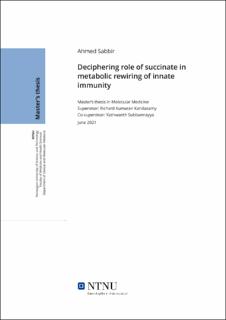| dc.description.abstract | Succinate is the anionic form of succinic acid, which is produced during adenosine triphosphate (ATP) synthesis via the tricarboxylic acid (TCA) cycle. In a biological system, succinate can be found in two forms. One is diethyl succinate which is cell-permeable, while the other form, disodium succinate, is cell non-permeable. Succinate has been found to be associated with inflammation through activation of the Toll-like receptor 4 (TLR4). However, succinate has also been found to induce both proinflammatory and anti-inflammatory cytokines. The aim of this project was to study how succinate affects the TLR4 inflammatory signaling. Lipopolysaccharide (LPS) is a well-established inflammatory cytokine inducer and is a ligand for TLR4. In this project, the experimental settings investigated how succinate affects the TLR4 signaling in the THP-1 cell line. For the experiments, phorbol-12-myristate-13-acetate (PMA) was used to differentiate THP-1 monocytes into macrophages, which were then stimulated with the four conditions: untreated control, LPS, disodium succinate, and a combination of LPS and disodium succinate. Western blots were performed to figure out which TLR4 signaling mediators were activated. RT-qPCR was conducted to investigate how succinate affects inflammatory cytokine release. Western blot results suggested that both LPS and disodium succinate activated the MyD88-dependent TLR4 signaling pathway strongly comparing to the MyD88-independent pathway. Furthermore, disodium succinate has been found to dampen; probably regulate LPS induced cytokine production. 18S and GAPDH were selected as endogenous controls for analyzing the mRNA expression of TNF-α, IL-1β, MMP9, and TGF-β1 inflammatory cytokines. The data suggest that both LPS and disodium succinate induced inflammatory cytokine release. Disodium succinate reduced LPS-induced mRNA expression of TNF-α and IL-1β, whereas no significant changes were observed with respect to MMP9 and TGF-β1 levels. To summarize, disodium succinate can strongly activate TLR4 signaling through MyD88-dependent, same as LPS. Both LPS and disodium succinate can induce inflammatory cytokine production. Furthermore, disodium succinate can probably regulate LPS induced inflammatory cytokines through disodium succinate-LPS crosstalk. However, the inflammation regulatory mechanism of succinate requires further investigation. | |
